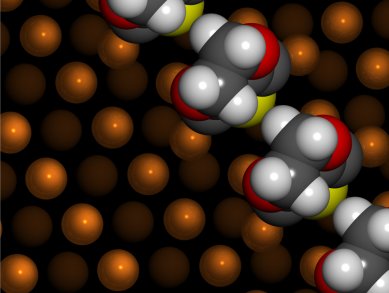A team led by Bobby Sumpter and Vincent Meunier, US Department of Energy’s Oak Ridge National Laboratory (ORNL), has grown highly structured short chains of poly(3,4-ethylenedioxythiophene), or PEDOT. They used copper as both the template and the catalyst for an Ullmann coupling reaction in which the inherent anisotropy of the fcc 110 facet confined polymer growth to a single dimension.
PEDOT and the copper lattice were imaged by using high resolution scanning tunneling microscopy and density functional theory calculations confirmed the geometry. The adsorption of PEDOT onto the surface was shown to be through the sulfur atom of the thiophene ring which causes an upright confirmation, rather than the rings laying flat on the copper.
This polymerization approach can be extended to many other halogen-terminated molecules to produce epitaxially aligned conjugated polymers which might be of central importance to develop future electronic and optoelectronic devices with high quality active materials. PEDOT is valued in electronics for its transparency, ductility and stability of its conducting state.
- Step-by-step growth of epitaxially aligned polythiophene by surface-confined reaction
J. A. Lipton-Duffin, J. A. Miwa, M. Kondratenko, F. Cicoira, B. G. Sumpter, V. Meunier, D. F. Perepichka, F. Rosei,
Proc. Nat. Acad. Sci. 2010, 107 (25), 11200–11204.
DOI: 10.1073/pnas.1000726107




